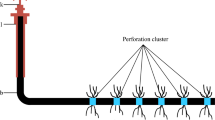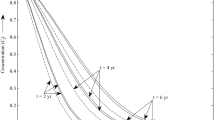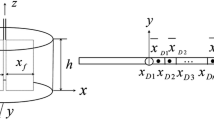Abstract
This study focuses on the transient analysis of diffusion of a contaminant ejected by an external source into a laminar flow of recovered water. The influence of density variation with contaminant concentration is approximated according to the Boussinesq approximation. On the basis of momentum conservation and mass conservation theory, recovered water flow and mass transfer partial differential equations (PDEs) describing contaminant diffusion are obtained. This problem under three kinds of boundary conditions is solved analytically using Laplace transform method. By comparing the actual measured concentration in horizontal well of X shale gas reservoir and the concentration obtained from the models, the type of boundary conditions of X shale gas reservoir is determined. After that, sensitivity analysis of the influence of each parameter on the concentration of contaminant is presented. The determination of boundary condition type can determine the fracture form, which provides the basis for the flow and diffusion of the fluid in the fracture. The model also can be quite useful for available necessary early warning methods for detecting or predicting contaminant concentration and hence help mitigate related environmental pollution by earlier instituting relevant decontamination measures.












Similar content being viewed by others
References
Abbasi, M., Dehghanpour, H., and Hawkes, R. V. (2012). Flowback Analysis for Fracture Characterization. Presented at the SPE Canadian Unconventional Resources Conference, Calgary, 30 October–1 November. https://doi.org/10.2118/162661-MS.
Barree, R. D. and Mukherjee, H. (1995). Engineering criteria for fracture flow back procedures [P].SPE29600.
Bergmann, A., Weber, F. A., Meiners, H. G., & Müller, F. (2014). Potential water-related environmental risks of hydraulic fracturing employed in exploration and exploitation of unconventional natural gas reservoirs in Germany. Environmental Sciences Europe, 26(1), 1.
Butkovskyi, A., Bruning, H., Kools, S. A., et al. (2017). Organic pollutants in shale gas flowback and produced waters: identification, potential ecological impact and implications for treatment strategies. Environmental Science & Technology, 51(9):4740−4754.
Camarillo, M. K., Domen, J. K., & Stringfellow, W. T. (2016). Physical chemical evaluation of hydraulic fracturing chemicals in the context of produced water treatment. Journal of Environmental Management, 183(Part 1), 164–−174.
Cheng, Y. (2012). Impact of water dynamics in fractures on the performance of hydraulically fractured wells in gas shale reservoirs [J]. Journal of Canadian Petroleum Technology, 51(2), 143–151.
Chinyoka, T., & Makinde, O. D. (2010). Analysis of nonlinear dispersion of a pollutant ejected by an external source into a channel flow. Mathematical Problems in Engineering, 2010(4), 242–256.
Chinyoka, T., & Makinde, O. D. (2013). Viscoelastic modeling of the diffusion of polymeric pollutants injected into a pipe flow. Acta Mechanica Sinica, 29(2), 166–178.
Ely, J. W., Arnold, W. T. and Holditeh, S. A. (1990). New techniques and quality control find success in enhancing productivity and minimizing proppant flow back [P]. SPE20708.
EPA (2016). Hydraulic fracturing for oil and gas: impacts from the hydraulic fracturing water cycle on drinking water resources in the United States (Final Report).
Ferrer, I., & Thurman, E. M. (2015). Chemical constituents and analytical approaches for hydraulic fracturing waters. Trends in Environmental Analytical Chemistry, 5, 18–25.
Finkel, M. L., & Hays, J. (2013). The implications of unconventional drilling for natural gas: a global public health concern. Public Health, 127(10), 889−893.
Gorder, R. A. V., & Vajravelu, K. (2011). Nonlinear dispersion of a pollutant ejected into a channel flow [J]. Open Physics, 9(5), 1182–1194.
Gregory, K. B., Vidic, R. D., & Dzombak, D. A. (2011). Water management challenges associated with the production of shale gas by hydraulic fracturing. Elements, 7(3), 181–186.
Hayes, T. D. (2009). Sampling and analysis of water streams associated with the development of Marcellus shale gas. Des Plaines: Gas Technology Institute.
Howarth, R. W., Ingraffea, A., & Engelder, T. (2011). Natural gas: should fracking stop? Nature, 477(7364), 271–273.
Hu, Y., & Mackay, E. (2017). Modelling of geochemical reactions occurring in the Gyda field under cold-seawater injection on the basis of produced-water-chemistry data and implications for scale management. SPE Production & Operations, 32(4), 449–468.
Hu, Y., Mackay, E., & Ishkov, O. (2016). Predicted and observed evolution of produced brine compositions, and implications for scale management. SPE Production & Operations, 31(3), 270–279.
Hu, Y., Mackay, E., Vazquez, O., & Ishkov, O. (2018). Streamline simulation of barium sulfate precipitation occurring within the reservoir coupled with analyses of observed produced water chemistry data to aid scale management. SPE Production & Operation, 33(1). https://doi.org/10.2118/174235-PA.
King, G. E. (2012) Hydraulic fracturing 101: What every representative, environmentalist, regulator, reporter, investor, university researcher, neighbor and engineer should know about estimating Frac risk and improving Frac performance in unconventional gas and oil wells[C]//Society of Petroleum Engineers.
Lan, Q., Ghanbari, E., Dehghanpour, H., et al. (2015). Water loss versus soaking time: spontaneous imbibition in tight rocks. Energy Technology, 2(12), 1033–1039.
Li, L., & Yin, Z. (2017). Numerical simulation of groundwater pollution problems based on convection diffusion equation. American Journal of Computational Mathematics, 07(3), 350–370.
Makinde, O. D., & Chinyoka, T. (2010). Transient analysis of pollutant dispersion in a cylindrical pipe with a nonlinear waste discharge concentration. Computers & Mathematics with Applications, 60(3), 642–652.
Moitsheki, R. J., & Makinde, O. D. (2009). Symmetry reductions and solutions for pollutant diffusion in a cylindrical system [J]. Nonlinear Analysis Real World Applications, 10(6), 3420–3427.
Nicot, J. P., & Scanlon, B. R. (2012). Water use for shale-gas production in Texas, U.S. Environmental Science & Technology, 46(6), 3580–3586.
Pakulska, D. (2015). Chemical hazards arising from shale gas extraction. Medycyna Pracy, 66(1), 99–117.
Park, I., Seo, I. W., Kim, Y. D., et al. (2016). Flow and dispersion analysis of shallow water problems with Froude number variation. Environmental Earth Sciences, 75(2), 1–12.
Rahm, B. G., & Riha, S. J. (2014). Evolving shale gas management: water resource risks, impacts, and lessons learned. Environmental Sciences: Processes and Impacts, 16(6), 1400–1412.
Shih, J. S., Saiers, J. E., Anisfeld, S. C., Chu, Z., Muehlenbachs, L. A., & Olmstead, S. M. (2015). Characterization and analysis of liquid waste from Marcellus shale gas development. Environmental Science & Technology, 49(16), 9557–9565.
Shukla, V. P. (2002). Analytical solutions for unsteady transport dispersion of nonconservative pollutant with time-dependent periodic waste discharge concentration [J]. Journal of Hydraulic Engineering, 128(9), 866–869.
Singh, M. K. (2012). Analytical solution for one-dimensional solute dispersion with time-dependent source concentration along uniform groundwater flow in a homogeneous porous formation. Journal of Engineering Mechanics, 138(8), 1045–1056.
Small, M. J., Stern, P. C., et al. (2014). Risks and risk governance in unconventional shale gas development. Environmental Science & Technology, 48(15), 8289–−8297.
Stringfellow, W. T., Domen, J. K., Camarillo, M. K., Sandelin, W. L., & Borglin, S. (2014). Physical, chemical, and biological characteristics of compounds used in hydraulic fracturing. Journal of Hazardous Materials, 275, 37−54.
Taylor, G. (1954). The dispersion of matter in turbulent flow through a pipe [J]. Proceedings of the Royal Society of London, 223(1155), 446–468.
Vanzo, D., Siviglia, A., & Toro, E. F. (2016). Pollutant transport by shallow water equations on unstructured meshes: hyperbolization of the model and numerical solution via a novel flux splitting scheme. Journal of Computational Physics, 321, 1–20.
Vengosh, A., Jackson, R. B., Warner, N., Darrah, T. H., & Kondash, A. (2014). A critical review of the risks to water resources from unconventional shale gas development and hydraulic fracturing in the United States. Environmental Science & Technology, 48(15), 8334–8348.
Wang, F., Pan, Z., & Zhang, S. (2017). Impact of chemical osmosis on water leakoff and flowback behavior from hydraulically fractured gas shale. Journal of Petroleum Science & Engineering, 151, 264−274.
Yost, E. E., Stanek, J., Dewoskin, R. S., & Burgoon, L. D. (2016). Overview of chronic oral toxicity values for chemicals present in hydraulic fracturing fluids, flowback, and produced waters. Environmental Science & Technology, 50(9), 4788−4797.
Ziemkiewicz, P. F., Quaranta, J. D., Darnell, A., & Wise, R. (2014). Exposure pathways related to shale gas development and procedures for reducing environmental and public risk. Journal of Natural Gas Science and Engineering, 16, 77−84.
Funding
This project is supported by the National Science Fund-Tianyuan Mathematical Fund (No. 11526173) and applied fundamental research (major frontier projects) of Sichuan Province (No. 16JC0314).
Author information
Authors and Affiliations
Corresponding author
Rights and permissions
About this article
Cite this article
Liu, Zb., Dong, Xx. & Min, C. Transient Analysis of Contaminant Diffusion in the Wellbore of Shale Gas Horizontal Wells. Water Air Soil Pollut 229, 221 (2018). https://doi.org/10.1007/s11270-018-3870-6
Received:
Accepted:
Published:
DOI: https://doi.org/10.1007/s11270-018-3870-6




